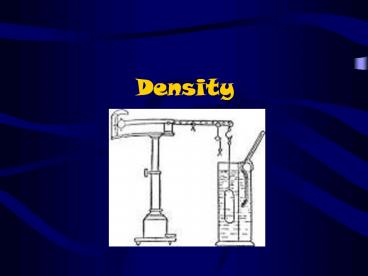Density - PowerPoint PPT Presentation
1 / 16
Title:
Density
Description:
Density When we compare the masses of the same volume of different substances we are comparing their densities. Oil floats on water because it is less dense than water. – PowerPoint PPT presentation
Number of Views:187
Avg rating:3.0/5.0
Title: Density
1
Density
2
What is Density?
- Density is the mass per unit volume of a
substance. - Density is measured in
- g/cm
- Kg/m
- g/mL.
3
- When we compare the masses of the same volume of
different substances we are comparing their
densities. - Oil floats on water because it is less dense than
water.
4
Density and the Particle Theory
- Every pure substance has its own characteristic
density. - Typically solids have greater densities than
liquids and liquids have greater densities than
gases.
5
- The particle theory states that different
substances have different sized particles. - The size of the particles determines how many
particles can fit into a given space. - Solids are tightly packed so they have a high
density, gases are spaced far apart so their
density is low.
6
Mass
- We can measure mass by using a balance or a
digital scale.
7
Volume
- Volume is a measurement of the amount of space
occupied by the substance.
8
How can we measure Volume?
- Liquids can be measured using a measuring cup or
a graduated cylinder. - Gases can be determined by measuring the volume
of the container it is in.
9
Volume
- Irregular solids can be determined by immersing
them into a beaker of water and measuring the
volume of the displaced fluid. - 4. Regular solids can be determined by measuring
the length, width, and height - V l w h.
10
- Displacement is the amount of space that an
object takes up when placed in a fluid.
11
Changes in Density
- As Temperature Increases
- ?
- Particles Gain Energy
- ?
- Particles spread out
- ?
- Decrease in Density
As Temperature Decreases ? Particles Lose
Energy ? Particles closer together ? Increase in
Density
12
What Portion of an Iceberg is Submerged?
- Think about what happens when you add an ice cube
to a glass of water? - Not all the ice floats on the surface, some of it
is below the surface. - This also happens with icebergs (90 of the
icebergs mass is found below the surface!)
13
Comparing Densities
- By comparing densities you can calculate how much
of something will be submerged. - Example Ice and sea water
- Density of Ice x 100
- Density of Seawater
- 0.92 x 100 89
- 1.03
- Approximately 90 of Icebergs are submerged!
14
Calculating Density
- The density of a substance can be determined by
calculating the massto volume ratio, or
density. - D M
- V
Mass
Volume
15
Example
- A cube of water has a volume of 2 m and a mass of
1000kg. What is the density? - Check to make sure the units can go together.
- D M 1000kg 500 kg/m
- V 2 m
16
Example
- What is the mass of 1500 mL of helium, if the
density of helium is 0.0002 g/mL? - m D x V m 0.0002 g/mL x 1500 mL
m 0.3 g































